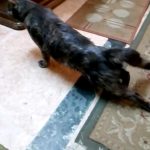Hello,
Please contact the surgeon or your vet ASAP. Really. ASAP. This doesn’t sound normal and an exam is indicated. Good luck.
Hello! I have a 14 month Bernese Mountain dog who has been limping for quite a while now. He started off with lameness shifting over all 4 legs, but now he is just lame in the front left. It’s constant and gets worse when he runs about and will hold his leg up. He doesn’t whine and it doesn’t prevent him from activities. I’ve reduced his walks to lead walks, and even reduced his walking to see if that helps but it hasn’t made a difference. He’s had an x ray of all four limbs, checking for hip and elbow dysplasia and his legs and joint all look good with no issues… We’ve been advised this is growing pains, which we suspected and heard is quite common in young large breed dogs. However, this lameness has been going on for a more than a couple of weeks and no sign of it getting better. Checked his paw pads and in between to see if there is anything stuck. No heat or swelling or cuts anywhere. Anyone else experienced prolonged lameness with no obvious source? Or any advise as to how I could identify a source? I’m just concerned something’s been missed as it’s been going on for a long time.
Comments
My 4yo Labrador Retriever Hank recently (two weeks prior) underwent a Tibial Plateau Levelling Osteotomy (TPLO) to repair the torn cruciate ligament in his back left knee. He gradually increased activity in the affected leg, but now seems as if his progress has halted. He’s very hesitant to put anymore weight on that leg. He won’t walk up a small step to get into my bedroom (this was the case before the surgery too). He moves around somewhat freely in the yard, but reverts to standing on three legs or doing a three-legged hop to move around at times. He has taken a bad step two to three times that resulted in a loud cry out. He must be coaxed to move around at all and appears to have developed a plum-sized seroma at surgery site of the infected knee. Could this be leading to the halt in activity/progress? He allows me to massage the muscles above and below the affected knee. We have also been doing some range of motion exercises on both legs.
Seroma?: He allows me to touch it and it is soft to the touch. It feels like a water balloon filled with a slightly more viscous fluid. It is directly above the incision site and the fluid appears to rest directly on top of the knee joint. Per vet recommendation, I discontinued the use of Rimadyl to try to reduce the size of the seroma.
Other symptoms: Licking at the base of tail to the point of seeing some blood in his fur. Excessive licking of the blanket he sleeps on.
Comments
Hi
My 4 y old cat had pyometraand hystrectomy and ovarian removal done 40 days ago . After the surgery, I noticed that she became less active and cannot jump as she used to do before.
Before she was used to jump easily and directly to get on the bed but now she climbs onto an adjacent arm chair and then walks to the bed Also before she was able to scratch her ear by her leg , but now she is not able to do that.
She’s trying but can’t raise her leg to her ear.
Is it possible that her legs become weaker as a complication of the surgery?
Is it normal for a cat to be less active for this long time after a pyometra surgery ?
What should I do to help her regain her normal movement ?
I really appreciate what you are doing , many thanks.
Comments
I have a question about our 13 yo dog who likely has a bulging disc. He is a mutt (probably part Border Collie, part Shepherd). Soon after a small slip on our stairs, he had lameness in his one back leg; this went away after one day, he limped for a few days after, and he quickly recovered from those things. Though he was walking fine fairly quickly, he showed stiffness, showed hesitation going up stairs unless we gave him a treat (we have only stairs to the outside), and his tail was down and only wagged from the tip of it. We had him quickly on an anti-inflammatory (Novox) and a pain med (started on Gabapentin but had to discontinue). He was fine on a walk; we went on short walks and he always craved for much more than we allowed. We prevented jumping, aerobic exercise, stopped him from using stairs by having a ramp to the outside, etc. We continued the Novox. His symptoms continued, then got better, and then seemed to regress when he started showing signs of pain (panting even when lying down and even when it was cool outside and some anxiety); the pain thing was probably because of taking him off Gabapentin. We took him to the Neurology Dept at a local, large vet hospital and a physical exam indicated that he “likely” has a bulging disc. When they inspected his back, he showed signs of pain and anxiety and his back legs bent and his rear went down. We don’t think we want to do surgery due to his age. He has not had an MRI as the regular vet and my husband and I thought that the treatment would be the same if we did not do surgery — treatment being restricting movement, continuing anti-inflammatory and pain meds, and looking into possible physical rehab. A switch to the pain med Amantidine helps a lot and the panting and anxiety are gone. He now continues to crave longer walks and, at the rare times we forget to block off the couch, he will try to jump up on it. We have been continuing to restricting movement but we just don’t know what to do about activity restrictions and have not had a lot of advice from neurology. He has always craved movement and exercise and when we take him around the block his stiffness seems to go away a bit and he seems energized and maybe even more comfortable. He has always craved a lot of exercise and movement. His spirits are lowered a lot if we keep in him in a small space — it almost seems like he wants to move around. He is eating and drinking, can do #2 (though he struggles some if doing it a long time). If allowed to do some movement, he is mostly happy and getting around with walking. Questions are: Should we restrict his movement altogether despite all this? Should he we do no walks at all? Is it bad if he is free to walk around the first floor or should he stay only in a very small area? I feel we are so confused as to what to do and how to know how to prevent regression. We’d love the input of any veterinarians or other owners with the same experience!
Comments
Hi Dr. magnifico! Curious on your thoughts on gabapentin for pain? I’ve read mixed reviews. My pup has a painful back leg. Originally she saw a vet at our practice who thought is was due to Lyme because she had tested strong positive and did not feel a drawer sign when checked. We did antibiotic treatment and the lameness got better for the most part. She would have some days where you could see it was bothering her. Then a few months later she was back to not bearing weight on it. Saw a different vet this time at our practice and this vet said he felt the drawer sign and said he felt it was injured CCL and reccomened a surgeon. Surgeon said would need to have x-rays to confirm which I haven’t had the money for. So we did pain meds (gabapentin and tramodyl) and rest for about a month and lameness went away again. She’s been good for about a year up until the past month or two and the vet gave gaba again. When she’s on it, she looks sleepy and scared. I’ve never had an issue giving pills with her in cheese on lunch meat or something but now she tries to spit it out. It’s like she knows what it’s going to do to her. I’ve read mixed reviews. I’ve also read it’s more for nerve pain? So I’m not sure if it’s actually relieving her pain or not. I’ve also read the reciptors that tramodyl targets, dogs don’t have? Curious on your opinion on all of this. I would like to see if she’s still a candidate for surgery even though it’s been some time but I need to come up with the funds for that so I’m trying to help her in the mean time. I give her vitamin supplements for her joints. I don’t want her on pain meds all the time but want something that gives her some relief on those bad days without making her feel drugged up.
Comments
Comments
My 5.5month old blue heeler hurt her back right paw. I believe it is one toe, she lets me press and extend her leg/joints with little reaction. When I move her 2nd toe to her side, or spread her middle two toes is when she lets me know it hurts. No whining or whimpering, she just gently puts pressure on my hand with her mouth.
Injury occurred yesterday, about 36 hours ago. Yesterday she would put the leg down, even ran a bit. Today she has the leg lifted/hanging above the ground. She will use it to jump up onto couch, I’m trying to limit her as much as possible. Other than that she is completely lame in her back leg. Paw has slight swelling. Not much at all.
Please help, I want to do what’s best for her, and am willing to do whatever it takes financially. But I am in a position where I need advice if seeing a vet is necessary, or to monitor and see if there’s improvement. I just don’t have the money to walk into my vets office unless I suspect I need to see a professional.
Comments
-
Anonymous I would have her on crate rest for 24-48 hours. This means no jumping on couches and all outside visits should be on leash for potty needs, then back inside. If it resolves itself in that time, then it’s just a strain or sprain of some sort. If it doesn’t, then you need to go to the vet.


















Not a vet, but someone who was heavily invested in Doberman breed education. We see this a lot in Dobermans fed puppy diets (not large breed puppy_. What are you feeding, and is it an adult or All Life Stages food? Have you consulted an ortho vet?